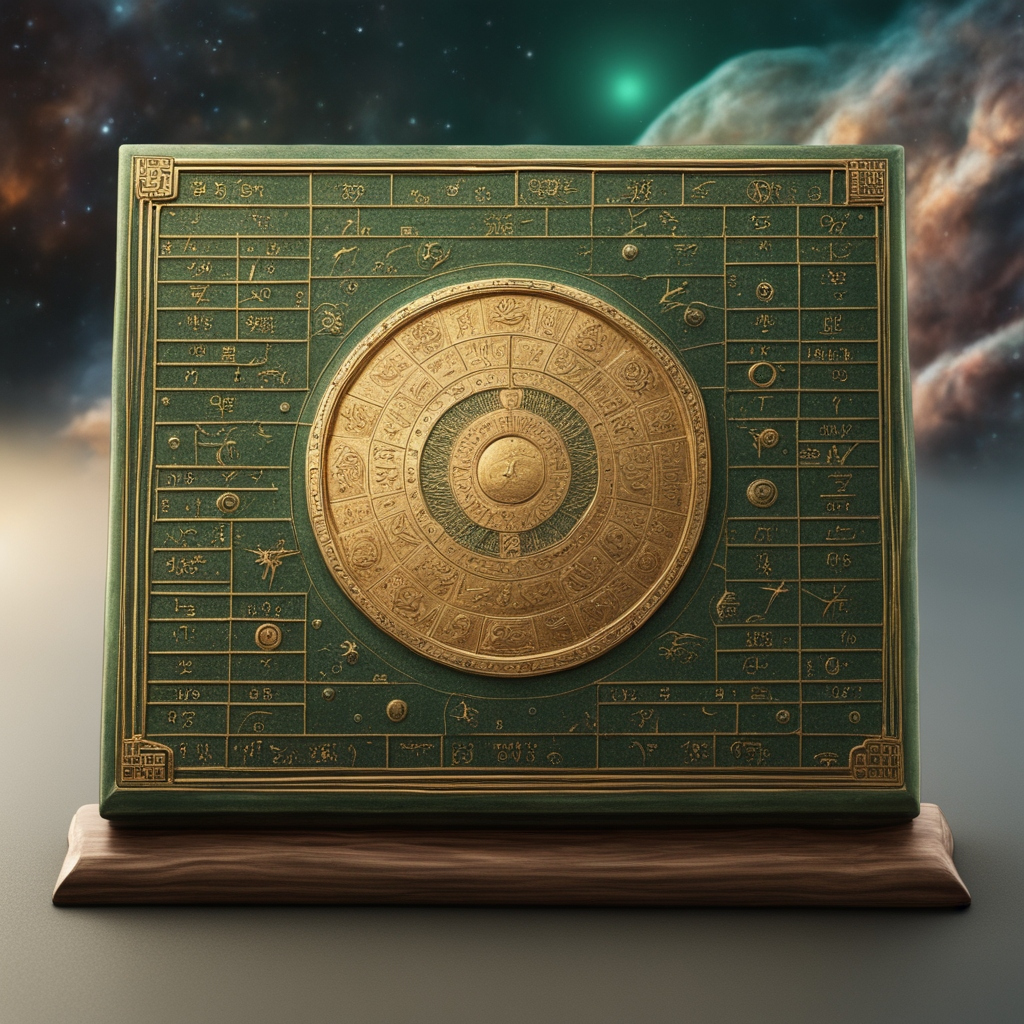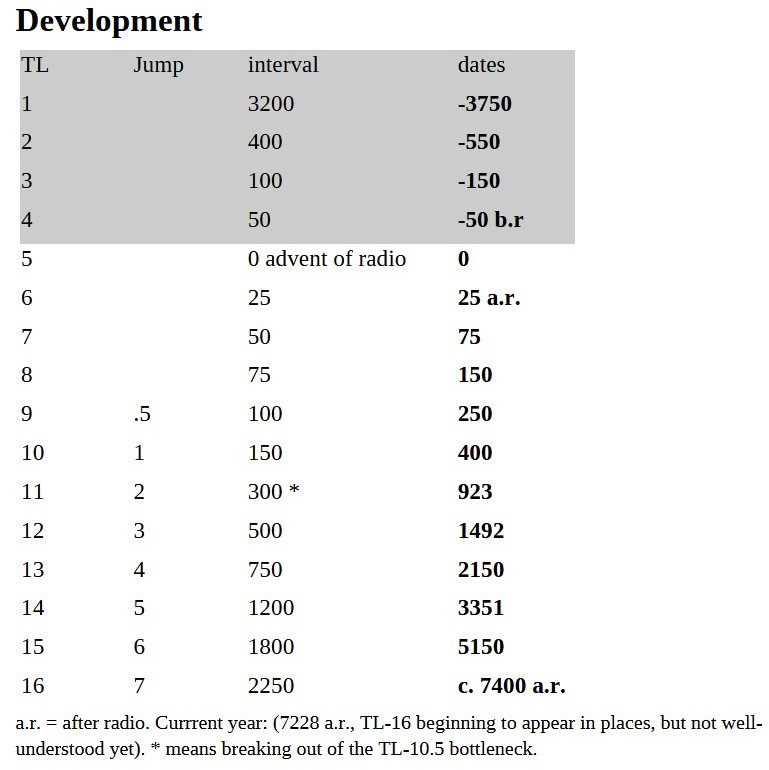
Scale
As with distance, Array time units are based on the artifact tablets, using standardized seconds, minutes and hours. Days are not defined, but the week is standard (168 hours), matching the duration of a jump, and the number of the week is the usual reference for dates. 52 weeks make up a standard year. Dates are in the form of week/year. So 25/7010 is the 25th week of the year 7010. Every 11 years, there is a two week festival, where the calendar is interrupted.
No one in the Array knows what these measurements were originally based on.
Interstellar scale differs from Charted Space, due to the 3D element. Each sector is an 8 parsec cube, 16 x 16 x 16 spaces. Each space on a sector map is half a parsec across. Because of the number of spaces in a sector (over 4000), there are no sub-sectors. Each sector usually has at least one name as well as a location.
The Exodus and Arrival
Almost a million years before the beginning of the campaign, humaniti sets outs in sub-light seed ships, fleeing an impending doom in their home galaxy. The ships are sent in waves, some racing ahead.
c. 75,000 years ago – The first automated processor ships arrive in the Array (the beginning of the Arrival). They find promising planets, many with indigenous life forms of two genetic types. These first ships are automated terraforming processors that begin searching for and finding candidate worlds, preparing them for habitability by altering their atmospheres and hydrospheres. Over the next 25,000 years, only these processor units take hold anywhere in the Array.
c. 50,000 years ago – The first successful seed ships find worlds now suitable to begin hosting life compatible with humans (Outsider life). For the next 20,000 years, small biological preserves begin to grow in spots on worlds around the Array. The seed ships bring progressively more advanced life forms, microscopic life at first, then fungi and plants, and then small animals. Some worlds are actually able to receive and sustain populations of larger animals, including cetaceans, birds, mammals, insects, reptiles, etc… Some of these worlds develop self-sustaining ecosystems that incorporate indigenous life forms while allowing Outsider life to survive. Over the next 20,000 years, several hundred worlds become host to some degree of Outsider life.
c. 30,000 years ago – Human cryo-ships begin to arrive in the Array.
These humans have had their memories modified. For unknown reasons, those who sent the colonists want them to develop mostly on their own, with only the most rudimentary of survival skills. Artifact tablets have been left on planets throughout the Array to help guide this new branch of humaniti at key moments.
By far the majority die off. Less than fifty worlds in the Array manage to reach stable human populations at first.
For the next 10,000 years, no world develops above TL-2.
Pre-history
c. 20,000 years ago – One world has discovered radio technology from clues on an artifact, skipping ahead in tech, so to speak. Not having used the scientific method to arrive at this, the people of that world, the First Ones, consider it to be like magic, allowing communication at distances. They innovate only slowly in other areas. On their radios, no signals are to be heard from other worlds. They look to the stars, but over time they forget to listen to them.
In technology other than radio, they never advance beyond TL2. The First Ones use bio-electric energy for their radios, eels at first.
c. 18500 years ago – Some of the First Ones use a native Flower organism as a substitute for eels, which are slowly becoming endangered, farmed to near extinction. By now, they also have rudimentary natural psionics integrated into their culture. Something about the world awakened them to it.
c. 18250 years ago – On another world, more than 20 parsecs away, the Bystanders achieve TL-3.
c. 18,000 years ago – The Bystanders achieve TL-5. Within a hundred years, they detect radio signals from the First Ones’ system, 20 parsecs away. The Bystanders use the eavesdropped information to accelerate their understanding. They have a rudimentary scientific method, and eventually a Newtonian understanding of basic physics, but they have learned some of the wrong lessons from the First Ones; their method is still archaic. Their use of rockets and photonic sails eventually becomes fairly advanced, but are very slow to make the quantum leap in their understanding. To them, light is a wave, period. For a very long time, they dismiss small discrepancies as arcane, and many who make quantum uncertainty claims are imprisoned or even executed.
Over the next thousand years the Bystanders emerge as the first space-faring people, spreading to their entire solar system. While doing this, they adopt a policy of silence, using primarily wired and tight-beam communications. They don’t try to contact the First Ones, only listening.
c. 17,500 years ago – The First Ones’ world suffers an asteroid collision, and their civilization is plunged into a death spiral. The Bystanders let the First Ones disappear over the next 500 years, never transmitting ideas, warnings or hope. Is it the original sin of the Array?
c. 17,000 years ago – The First Ones’ understand of radio finally fades, as the planet becomes balkanized, and the survivors descend all the way to TL-1.
The Bystanders have expanded into their entire solar system, though they are still slow to advance technologically.
In the centuries that follow, with no First Ones to worry about, the Bystanders become more lax with their secure transmissions, and eventually their civilization becomes radio ‘noisy’.
c. 16250 years ago – The Bystanders civilization is no longer alone. Another world, home of the Precursors, has innovated radio, and listens to the Bystanders’ transmissions, even though the signals they receive are well over a century old, due to the distance between the stars. This new world follows in the Bystanders’ footsteps, and restricts the information they broadcast to the stars.
The Precursors arrive at a theory of relativity, an improvement on the ideas of the Bystanders they are learning from. Still, like the Bystanders, they are reductionists, and so they struggle with the randomness of the quantum realm.
Even though the Precursor culture died long before recorded history, outsiders know from archeology that they would be the first to spread out to other systems in a way that truly took hold. Some of the nearby seeded worlds slipped by during the colonization phase of the Arrival, and so over the centuries that follow, the Precursors send generation ships to several worlds. They won’t arrive for hundreds more years.
Two of these worlds will eventually develop to a high enough level that they are able to send out colony ships of their own. The process has begun, and humaniti begins to spread.
c. 15,500 years ago – The Bystanders have been able to send a manned expedition to a nearby star at subluminal speed, using photonic sails and primitive cryogenics.
c. 15,000 years ago – Other worlds are innovating radio, and some have discovered and deciphered artifact tablets, leading to other advances. Increasingly, worlds hear the radio chatter, and begin to view the Bystanders as the standard for interstellar greatness, and follow their lead, hoarding technological breakthroughs.
c. 14,500 years ago – Two new worlds in other systems, partially terra-formed by earlier seed pods, are colonized by the Bystanders. Soon after that, the home world finally accepts the heresies of relativity and quantum theory. As is their pattern, they don’t share it with the colonies, or even the public on the home world.
c. 14,000 years ago – The Bystanders’ home world has developed nukes, and at a politically dangerous moment, they destroy the centers of knowledge, leading to a collapse of their top-heavy technological base. The leaders that arise in the aftermath blame science for the disaster that befell their people, and make technology above TL-2 illegal.
The stranded colonies struggle to survive. Both of the colonies retain radio technology at first, but are several parsecs apart, so their exchanges are slow, and once again neither advances past TL-5. Radio is the last ‘easy’ technology, before requiring theoretical advancement. Eventually, one of the colonies fails, and any that survive regress in their tech level, losing radio. The colony that does survive never leaves their planet again. The Bystanders’ culture turns out to be a dead end.
c. 11,000 years ago – One precocious world learns enough through deciphering an artifact tablet to discover gravitic and jump tech. Like so many early kingdoms, they are not forthcoming with their discoveries, and so are unopposed as they spread out to local stars in range. They run into the TL-10.5 bottleneck, unable to progress to jump-2, keeping them in a tight 4 star system network, Eventually their home world suffers an ecological disaster from overpopulation. The culture doesn’t survive, and once again any remnants keep at best TL-5. Over the next 3,000 years, more small kingdoms spread at subluminal speeds to the stars around them. Advances are made in technology, but it isn’t shared widely, and no other kingdom gets jump tech, grav tech or nuclear dampening. Most inhabited worlds still have at best radio technology.
c. 9000 years ago – Even more worlds have been reached by subluminal craft, spreading humaniti to hundreds of worlds throughout the Array. At about this time, jump tech is independently innovated by two kingdoms, not very close to each other. Both use it within their own spheres as a military advantage to bring local stars under their control, and they both guard the technology. Both of these early jump kingdoms last hundreds of years, but neither breaks out of the bottleneck, and neither culture persists into the first era, though news of their jump tech has made it clear to the Array that jump drives aren’t a myth.
Now that hundreds of worlds around the Array are inhabited, cultures are rising and falling, as they each have their own sagas. Information is spreading at the speed of light throughout the ‘civilized’ worlds (those with radio), but no one is effectively sharing their technology, following in the footsteps of the Bystanders. At the end of this period, more small jump networks are springing up, but the bottleneck persists, as fear keeps worlds from openly collaborating.
c. 8000 years ago – The first truly interstellar war is fought between two early jump kingdoms. Supply issues make aggression unsustainable, and both kingdoms are forced to withdraw from the contested system.
Historical Eras
7228 years ago – the beginning of the first era is when the first ‘modern’ world innovates radio. Kushokore’s population was itself a transplant from another part of the Array that had descended to TL-2 after colonization. In the year 0 a.r., they re-discover radio and begin listening and learning and collaborating with two other fairly close systems, leading to the Sharer culture. Radio had been around for thousands of years, and jump technology had even been innovated by some kingdoms, as high as TL-10.5. But this new sphere that arises, over 7000 years before the game’s beginning, is different. The kingdoms involved have a more sophisticated scientific method, and a quantum theory. But they have something else, an international spirit, trusting other inhabited worlds around other stars with their ideas. A local enriched interstellar exchange of philosophies, approaches and discoveries, is how the Array gets out of the TL-10.5 bottleneck.
That first kingdom of the first era doesn’t exist, hasn’t for thousands of years, but their home world is still inhabited, and the accepted history of the Array is traced to that world and the early interstellar culture that rose up around it. Kushokore and the other Sharer worlds are in Sallumin space, near the top of the Array.
In 1492 a.r., TL-12 (jump-3) finally allows truly effective access to the wider Array. Later, as kingdoms get more spread out, feudalism begins to be adopted a method of interstellar government, but many are slow to adopt it, some even into the present.
2866 – The founding of the First Dominion marks the beginning of the second era, when technology and culture made huge jumps, especially in the Deep of the Array.
5718 – The founding of the Compact marks the beginning of the third era, which continues into the present.
Development
These are the rough dates for highest technological achievements.

Timeline

Dates across much of the Array use a timeline, based on the development of that first Sharer world of Kushakore, dating from when that world developed radio. Other stuff from before year 0 can be disputed, sometimes based on politics or religion, and of course, individual planets have their own histories and timelines. The pre-calendar timeline is not widely known in the Array, and though archaeology has allowed much of it to be gleaned, just as much is murky or disputed.
The timeline becomes interstellar at year 0, because even though they hadn’t left the planet yet, Kushakore’s interaction via radio with other Sharer worlds was the catalyst that led to breaking out of the bottleneck, and thus the origin of the first era dates back to that time. After year 923 (when jump-2 was first innovated, clearing the bottleneck), the tech level refers to the highest attained anywhere in the known Array (not always at first by the same kingdom).
Dates
First Era
0 – The first Sharer world innovates radio, beginning the first era.
201 – Sublight colonization of Almerand in a distant part of the Array.
923 – The Sharers culture develops jump-2 and begin extending their network of star systems. Within a hundred years, several more kingdoms develop jump-2 and stellar networks begin to expand.
1492 – First Jump-3 mission to explore the wider Array, patiently using the new fuel refining equipment at each stop, to avoid mis-jumps, and able to find gas giants and other fuel sources in unexplored systems. They set out on a years long mission, knowing of some other kingdoms to visit, due to radio, but also finding a few pre-radio cultures on planets.
1912 – Colonists from Asha’ad arrive on Shadir 3.
2248 – Sallumin innovates radio.
2572 – Glinde accept patronage of Unsaag.
Second Era
2866 – Founding of First Dominion (of Angu), unifying Vieden.
3001 – Dominion develops jump tech.
3179 – Dominion settles Gelloine.
3351 – First Dominion achieves jump-5
3644 – Ushanti Union founded in the Heights of the Array, under psionic rulers.
4140 – A supernova triggers the collapse of the First Dominion
4212 – Shadar adopts their Constitution, creating the Senate and limiting the powers of the Aristocracy.
4614 – Founding of Second Dominion (of Cinsuala).
4739 – Collapse of Second Dominion.
4801 – Founding of Triene (combining Triene with Tualt).
5368 – Shadar innovates jump-2. The Shadar Empire is founded. Tensions with the Ushanti Union, who have been covertly destabilizing the Golden Braid for generations, begin almost immediately.
5486 – Great Purge in the Shadar Empire. Vicitat flee from the Empire into the Void.
5491 – Vicitat assume control of the primitive world, Sactornat, addicting its pre-radio humans to Hafferin.
5503 – 5559 – First Shadar/Ushanti War
5662 – Shadar Empire conquers final cluster of the Golden Braid.
Third Era
5718 – Founding of the Compact, and ratification of the Edicts.
6506 – Dominion of Morath founded (adopts the mantle of Dominion, becoming one of the major kingdoms).
6508 – The Dominion formally applies for Compact membership. They are accepted two years later in 6510 a.r., very quickly to gain their support against the perceived growing Ushanti danger.
6512 to 6525 – The Ushanti War (also called the Thirteen Years War), leading to the almost complete collapse of the Union, and subsequently driving the Vicitat from the center of the Array. Triene invites them into the Deep (big mistake).
6569 – The Shadar Empire applies for Compact membership. The process drags on. There is resistance, as they have waged war on several signatories in the past.
6604 – The Shadar Empire is accepted by the Great Council as a signatory to the Compact.
6632 – 6670 – The Shadar Morathi War.
6719 – Almerand placed on 10 year probation, for a transgression against the first Edict.
6795 – After a decades-long plan of drugging the populace of Triene, including members of the military, the Vicitat force a settlement with the Queen of Triene. and the signing of a new agreement, effectively conquering Triene.
? First and second Kloor Wars between Aenon and the Tomok Republic and, later, the Small Entente.
6820 – The Compact expels Triene.
6956 – 6958 – Genetics War between the Compact (all but Sallumin) and Triene, compelling Triene to sign an agreement not to pursue artificial genetic manipulation, on pain of losing the Pocket.
7011 – The Raylo devastate the worlds of the Three Fools.
7153 – Contention between Almerand and the Dominion over the administration of Vieden (Capital of the First Dominion). Both sides muster forces, anticipating conflict.
7195 – Osterosza takes advantage of the distractions and declares independence from the Dominion of Morath.
7198 – The Shadar Empire engineers a quick acceptance of Osterosza into the Compact. Tensions rise between the Dominion and the Empire once again as a result.
7228 – The present.

